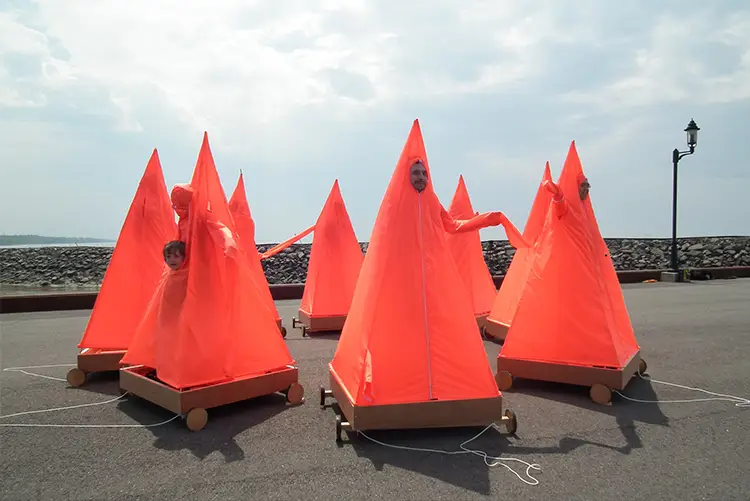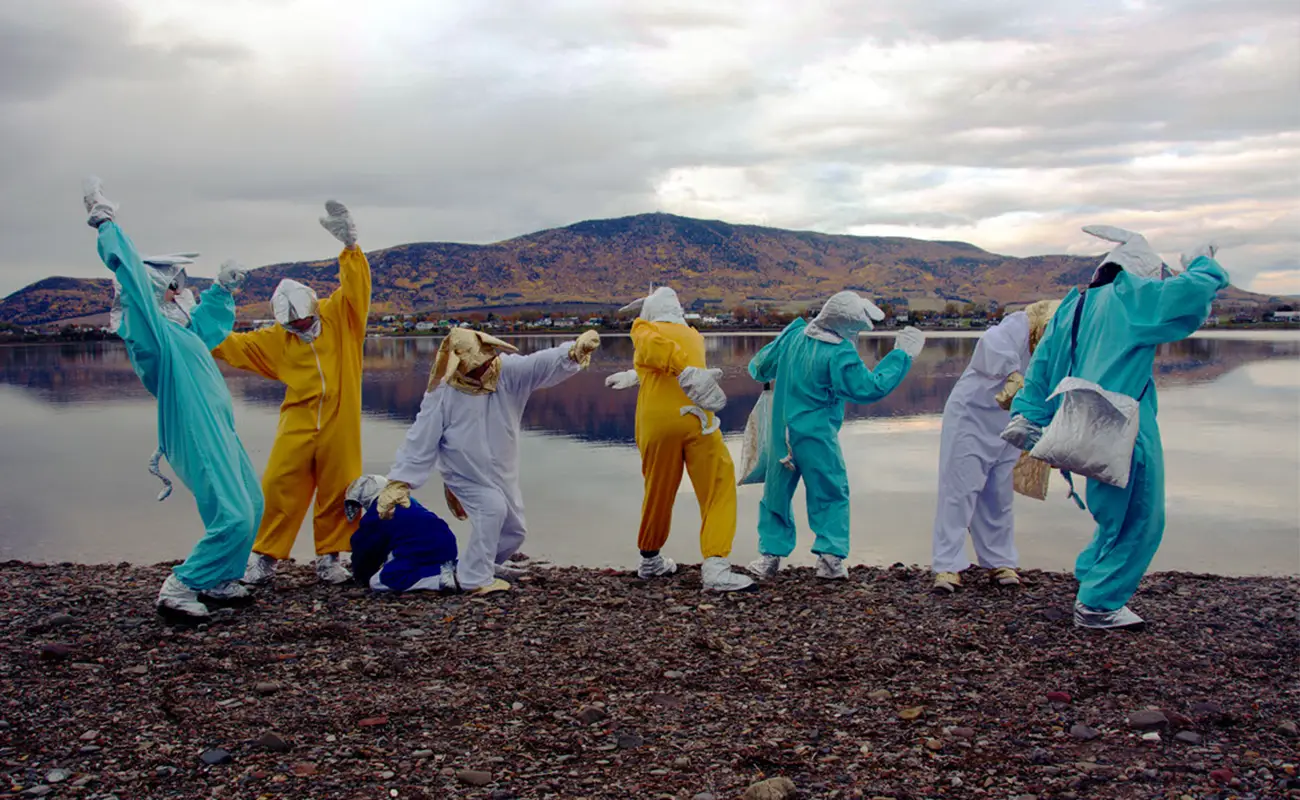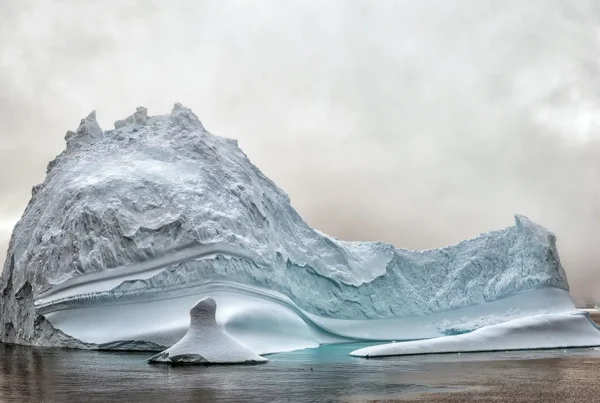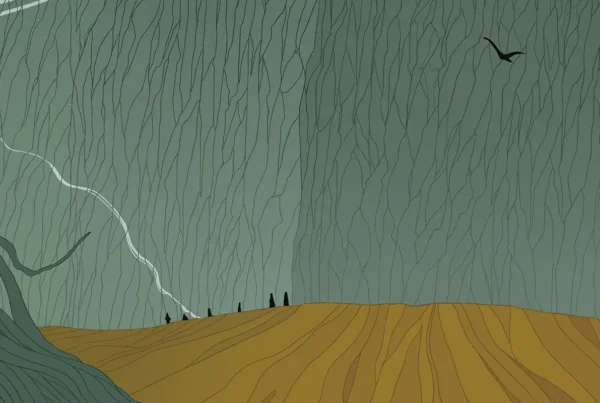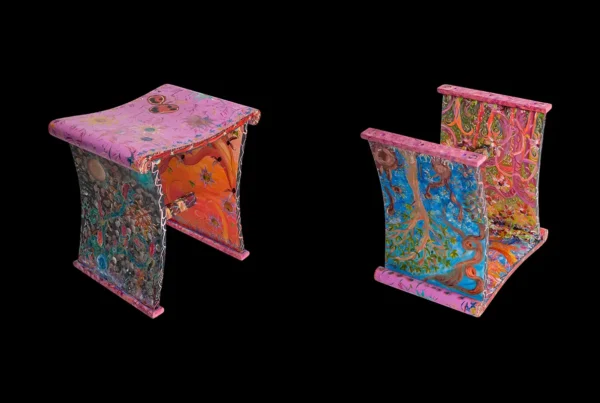“Art offered me a space where that discomfort could transform into something generative—it allowed me to explore, without words, what it means to be present, to connect, to be human.”
Rooted in Nature, Carried by Curiosity
Christine Comeau‘s artistic journey emerges from a profound connection to the landscapes of her upbringing and an ever-present desire to explore the subtleties of human experience. Raised in Saint-Gabriel-de-Brandon, a small village in Quebec’s Lanaudière region, she spent her early years surrounded by water and wilderness—a setting that continues to inform the symbolic language of her art. Waterways, in particular, surface repeatedly in her photography and visual narratives, serving as metaphors for fluidity, memory, and connection. Comeau’s deep ties to place and movement have shaped the foundation of a multidisciplinary practice that resists rigid categorization, flowing seamlessly between textile sculpture, video, installation, and performance.
Her creative trajectory began with a passion for drawing, painting, collage, and writing poetry—early modes of expression that allowed her to navigate feelings of estrangement and otherness. However, during her first year at university, Comeau encountered a significant creative block, a moment of silence in front of the canvas that forced her to reconsider her approach. This period of questioning and frustration became a catalyst for transformation. She turned away from traditional mediums and sought out materials and methods that felt more embodied and meaningful, eventually leading her to textiles—a choice that would come to define much of her artistic voice.
Travel and movement are not just thematic concerns in Comeau’s work; they are also practical realities of her life. Frequent relocations and the experience of inhabiting multiple homes and cities have heightened her sensitivity to displacement, mobility, and the nuances of interpersonal connection. These experiences, paired with qualities she identifies as essential to her practice—perseverance, patience, resilience, curiosity, and a healthy dose of self-mockery—infuse her art with a sense of fluid adaptability and emotional depth. Her work consistently seeks to translate these lived experiences into tactile, visual, and sensorial forms, offering audiences an invitation to engage with the spaces between presence and absence, belonging and estrangement.
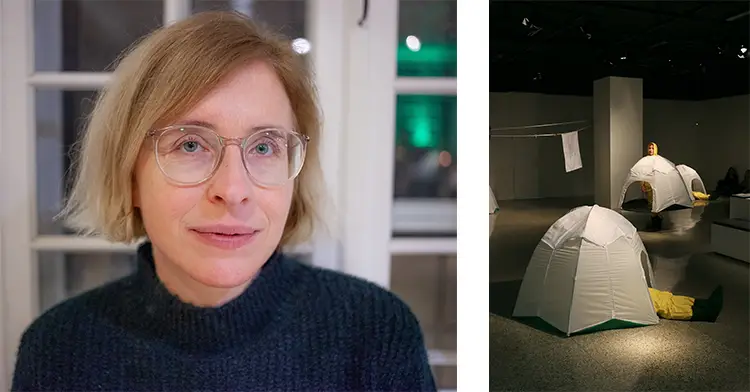
Photo credit: Inventer le pays, 2019. © Melissa Amero.
Christine Comeau: Between Visibility and Vulnerability
Rather than pointing to a single moment of decision, Christine Comeau describes her path into the arts as an organic unfolding. Creativity was not a career choice but an intrinsic mode of engaging with the world, especially in moments where she felt out of place within its social frameworks. Artistic gestures—drawing, building, writing—became her way of articulating what words often failed to capture. The discovery of the Surrealist movement during her teenage years sparked an initial ambition to become a surrealist painter, but this aspiration quickly evolved into something broader and less defined by genre or tradition.
This sense of not fully inhabiting the expected contours of identity or social space is a recurring thread throughout Comeau’s reflections on her creative process. Art, for her, is not merely an act of expression but a means of negotiating presence—a way to transform discomfort into generative exploration. Through material engagement and performative gestures, she explores what it means to connect, to be seen, and to exist authentically within both individual and collective contexts. Her choice to work across multiple mediums speaks to this expansive approach, where the body, materials, and space are not separate entities but participants in an ongoing dialogue.
Over time, Comeau’s practice has matured through educational pursuits and immersive experiences such as residencies, collaborations, and exhibitions. These opportunities allowed her to expand her technical repertoire while deepening the conceptual underpinnings of her work. What continues to drive her is the urge to give form to the unseen—to manifest internal landscapes, emotional states, and social dynamics into tangible, interactive experiences. Her projects consistently explore the labor of connection, the friction of coexistence, and the subtle negotiations that define relational spaces.
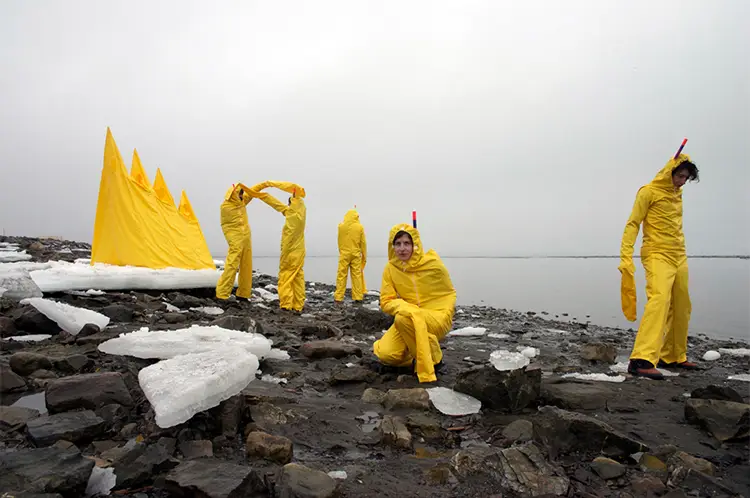
The Poetic Weight of Material and Gesture
Christine Comeau’s artistic vocabulary is distinguished by its intuitive yet conceptually rigorous approach. Working fluidly between sculpture, installation, photography, video, and performance, she cultivates a body of work that examines the complex relationship between the human body and material world. Textiles, in particular, have become central to her practice—not only for their tactile softness and symbolic association with care and vulnerability but also for their flexibility and proximity to the human form. Garments, fabrics, and stitched forms serve as conduits for memory, transformation, and interpersonal connection.
Recurring motifs throughout her work include fatigue, interconnection, transformation, care, and the subconscious. These themes often materialize through interactive textile sculptures designed to physically link two or more individuals. Such works require participants to negotiate their movements and rhythms together, turning the act of cohabitation into a visible, embodied process. This engagement exposes the invisible labor involved in maintaining relationships, highlighting the delicate balance between autonomy and interdependence. Through these tactile experiments, Comeau constructs poignant metaphors for the emotional and physical work of living alongside others.
The tension between freedom and constraint—especially as it relates to displacement and mobility—remains a persistent source of inspiration for Comeau. Her sculptures frequently reflect the dual nature of movement as both liberating and limiting, exploring how the need to adapt can generate both friction and intimacy. These works do not merely illustrate connection; they enact it, asking participants and viewers alike to feel their way through the complexities of shared space and collective experience. In doing so, Comeau creates art that is not only seen but felt, inviting a slow, deliberate engagement with the gestures that bind us.
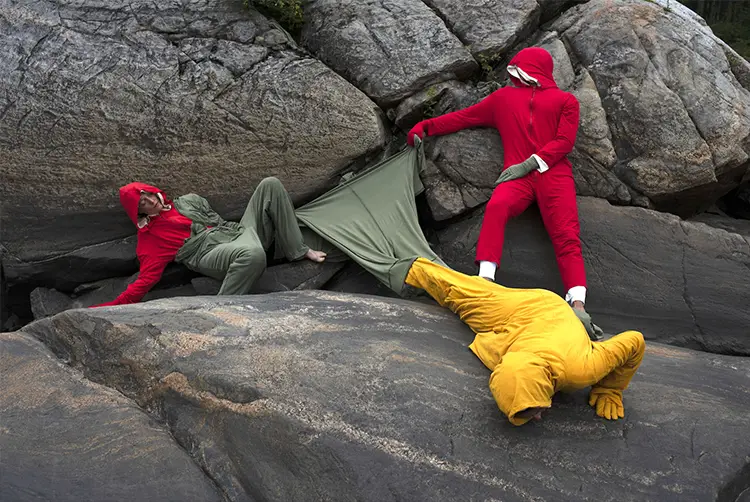
Christine Comeau: Shedding Skins, Shaping Dreams
One of Christine Comeau’s most significant projects, Le dépouillement de l’anguille (The Skinning of the Eel), serves as a powerful articulation of her artistic philosophy. This multidisciplinary work operates as a metaphor for identity, transformation, and the shedding of social and cultural expectations. The project unfolded in multiple stages, beginning with the creation of tracksuit-like garments—soft, second skins designed to be worn and gradually removed during an in-situ performance along a riverbank in Northern Lac-Saint-Jean, Quebec. Three dancers—James Viveiros, Maria Kefirova, and Sara Hanley—brought the work to life through slow, deliberate gestures that embodied vulnerability, release, and metamorphosis.
Choreographed in collaboration with Sarah Bild, the performance centered on the act of shedding these skin garments, symbolizing the casting off of externally imposed identities. The dancers’ interactions with the landscape and each other generated a palpable tension between exposure and tenderness, making visible the quiet labor of personal and collective transformation. The ephemeral nature of the performance was integral to its meaning; what remained were fragments—videos, photographs, and the emptied garments themselves—presented later in an immersive installation at L’Œil de Poisson gallery in Quebec City. Here, large-scale video projections and fabric-printed photographs recreated the dreamlike environment of the performance, inviting viewers into the intimate process of undoing and becoming.
This participatory dimension extended into the exhibition space, where visitors were encouraged to step into the garments and enact their own gestures of symbolic shedding. This invitation to engage physically and emotionally with the work deepened its resonance, transforming spectators into participants within the cycle of vulnerability and renewal. Through Le dépouillement de l’anguille, Comeau illuminated the profound intersections of body, identity, and material, affirming her commitment to creating spaces where art becomes a site of shared reflection and embodied experience. The project remains a defining example of how her work bridges personal introspection with collective inquiry, turning soft materials into vessels of meaning and transformation.
